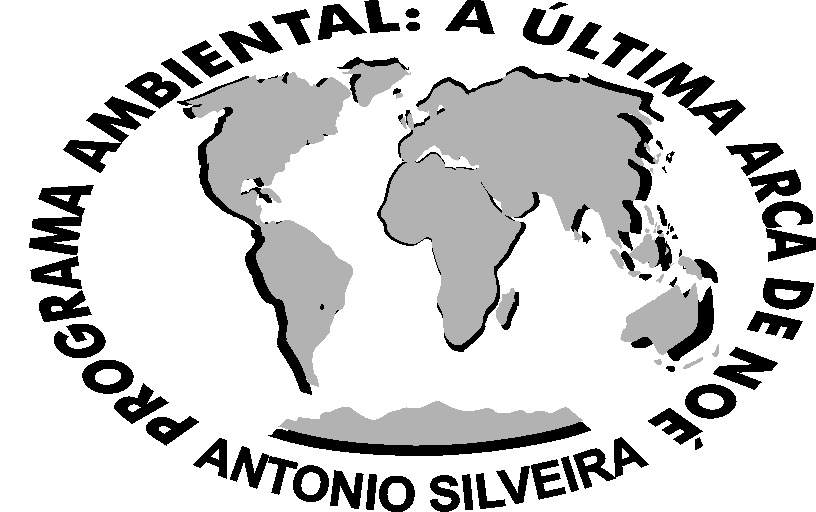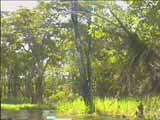
BRAZIL'S ECOSYSTEMS
Listen to the back sound

BRAZIL'S ECOSYSTEMS
AMAZON FOREST

Definition
The Amazonian Rainforest is distributed for around 5 million Km2 reaching in Brazil the following States: Amazonas, Amapá, Acre, Roraima, Rondônia, Pará, Tocantins Maranhão e Mato Grosso, which consists of Amazônia Legal.
Amazonas River basin, with its 7 million km2 is the main existence factor of the forestall complex known as Amazonian Rainforest, because besides providing the necessary humidity, its waters function as seeds dipersors agents.Kinds of the Forest
The Amazonian Rainforest besides firstly looking uniform, in the truth has a big diversity, being possible the identification of a lot of kinds of vegetation, associated to different ecological systems, as:
- Firm Land Forest: with high trees that become up to the high of 65 m, and its tops form light screens, making the forest interior humid and hot. This area is not submitted to floods.
- Meadow Forests: it is between firm land and igapó
- Igapó Forests: they are located in low grounds that are temporally or permanently flood by rivers waters.
- Igarapé Forests: they are forests that can flood, in the rivers banks that flows in bigger rivers.
- Scrubs: there are some scrub formations that have stayed, but that are not so important as equatorial forest.Biodiversity
The Amazonian Rainforest has the biggest biodiversity in the world because of its extension and association of ecosystem variety. There is much to discover in relation to vegetal species.
- Flora: around 30 thousand plants species, being 2,5 thousand trees species.
- Fauna: The Amazonian forest fauna riches, for sure, is not already completely known. But we have already identified that there are a lot of species, mainly: Panthera onca, Alouatta sp, Tapirus terrestris, Arapaima gigas, Trichechus inunguis, Inia geoffrensis.Protective legislation
Our Federal Constitution considers the Amazonian Rainforest as National Heritage.Forests multiple use
A lot has been talked about the forests preservation necessity, being created maps biodiversity importance area destined to the implantation of forests and national parks. This preoccupation is not non-sense, because of the big the devastation of our forests, because as data from FAO, around 200 million forest hectares were destructed from 1980 to 1995 (Bol. nº46, 7/97, ONU em Foco).
But which is the environmental importance of forests? Which are their utility and ways of use? And also what can be questioned about the subject are what we are going to talk about.
In biological and environmental terms it is known that forests provide mainly the maintenance of life's conditions for million ways of vegetal and animal life; maintenance of necessary humidity for the existence of propitious weather to life and quality of hydrical resources. It makes them really important in the environmental global system and consequently benefits human environment.
However, up little time ago were considered "development obstacles", so that were destructed with no criteria and there were not propitious environment for contrary voices. Now, because of these recent proves of its biological and environmental functions, added from the big necessity of food demand, it is indispensable its economical exploration, providing resistance o its destroy. The entire forest started representing more riches instead of destroying for starting any other activity. So, for its importance and rich diversity, plus technological development that has allowed th discovery of new natural fonts, forests can and must be profited.
Moreover, forestall resoucers exploration has been shown excellent each time more. From the exploration of its big vegetal diversity has been possible the development of local development processes, fixing and giving opportunities to its needy communities. From its biodiversities has been emerging important pharmacological discovers to humanity, which must have the exploration ruled. From its native population we have been having some information directly related to these new discovers. From its fishing resources depends on million people surviving. We can also observe that from the rational use of scenic beauty of a lot of its places will be the world ecotourism future, employing million people, generating rich economy. It shows the multiple use they can and must have.
But, if we do not preserve virgin big extensions of our forest, as Conservation Units, it will be impossible the maintenance of our rich heritage for the future generations and the forest's future is totally endangered.Reproducing a forest
There is in the Natural History Museum, in New York, the Biodiversity Hall, result of years of studies and investment of million of dollars, which brings the last information and scientific conclusions about the subject. There are the mainly ecosystems of the Earth, with representative of fauna in rich panels with scientific information of high technical level, and also of easy general public access, where the threatens to life in the Earth by the excessive exploration of natural resources are also shown. Computers provide more details about the exposition to visitors. The window that is called "Life's Specter" shows a great variety of animals species- 1500, representing groups from microbes to mammals in nine ecosystems of the Earth, showing this way the exuberance in the presentation.
There is also the impressive diorama, representing the tropical forest of Dzanga-Sangha, a reserve in the African Central Republic that as said in the folder is the biggest diorama in the world. Having 2,500 feet it uses a high technology image and sound system, reproducing the behavior of animals moving, as also the illumination effects show different hours in a day in a forest. All the vegetation was detailed reproduced leaf by leaf, branch by branch, giving us the impression of being a real forest, besides, there is also the sensation of humidity, heat and smell. Computers give access to the BioBulletin with information about biodiversity world events and explanation about species extinction processes.
The panel "Resource Center" shows disastrous human activities, as the forms, methods, rules and ways for avoiding biodiversity degradation.
So, humanity starts knowing and noticing the forests importance and their biodiversity for life's future, and so starts running against time for saving what we still have as life variety. In this path, expositions as the Biodiversity Hall of the American Natural History Museum, where the splendor of the Earth's diversity is revealed and how to preserve it, must be spread and visited, so we can really reflect about our future and from the another ways of life of our beautiful blue planet, which can be understood as "The Last Noah's Ark".Economical vocations of the Amazonian Forest
The Amazonian forest has an immeasurable riches, as the power of its products. Many ways of enjoying these products can be developed, but all of them, with no exception, must be well planned for being done in a way that cause the lesser environmental impact.
- food products extrativist exploration as: açaí (pulp and juice powder), jarina (bijou and jewels production), cupuaçu (pulp for juice).
- ecotourism exploration;
- fishes culture: with noble species.Threats
- unforestment for agriculture and pasture;
- irregular exploration of wood;
- uncontrolled invasion;
- biopirataryInformation
- In the Neotropical Region that consists of the American continent, there is 57% of tropical and equatorial forests of the planet, being calculated that 37% of reptiles, 47% of amphibians, 27% of mammals, 43% of birds and 34% of all the plants occur in this region (Project "Parques e Reservas, do Ministério do Meio Ambiente dos Recursos Hídricos e da Amazônia Legal para o PP-G7". vol.1).
- In its world biodiversity map, the Conservation International points Brazil as the planet of biggest biodiversity in the world.
- In the forests of high Amazonian Forest live the smallest primate of the world: Cebuella pygmaea.
All Rights Reserved